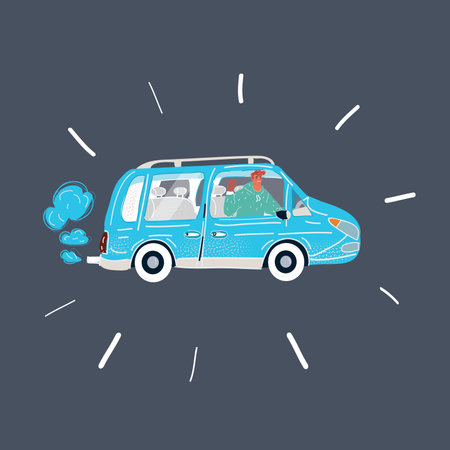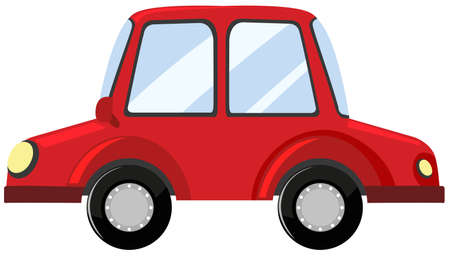1. Understanding Vehicle Idling
Vehicle idling happens when your car’s engine is running, but the vehicle isn’t moving. This is more common than you might think and is often part of everyday life for many Americans. Whether it’s waiting at a drive-thru, picking up kids from school, or letting the engine warm up on a cold morning, most of us have let our cars idle at some point.
Common Situations Where Idling Occurs
| Situation | Description |
|---|---|
| Drive-thrus | Waiting in line at fast food restaurants or coffee shops with the engine running |
| School Pick-ups | Sitting in car lines while waiting to pick up children after school |
| Warming Up Vehicle | Letting the car run to heat or cool the interior before driving off, especially during extreme weather |
| Traffic Jams | Stuck in heavy traffic where frequent stops keep the engine running but the car stationary |
| Curbside Waiting | Waiting for friends or family outside stores or homes without turning off the engine |
General Misconceptions About Idling
- “Restarting uses more gas than idling.” Many believe that turning off and restarting the engine wastes more fuel than leaving it running, but modern engines are designed to start efficiently, making this a myth.
- “Idling is good for warming up your engine.” While it’s true engines need to reach operating temperature, today’s vehicles warm up faster when being driven gently rather than sitting still.
- “It doesn’t really waste much fuel.” Even short periods of idling add up over time, leading to unnecessary fuel consumption and higher costs.
The Takeaway on Idling Habits in America
Understanding what idling is and when it happens can help drivers recognize just how often they might be wasting fuel without realizing it. By addressing these common situations and misconceptions, we can start thinking about ways to minimize unnecessary idling and reduce wasted fuel.
2. How Idling Impacts Fuel Consumption
The Science Behind Idling and Fuel Use
When your vehicle is idling, the engine is still running, which means it continues to burn fuel even though you’re not moving. The combustion process inside the engine uses gasoline or diesel to keep the motor turning, run accessories like air conditioning, and power electronics. In simple terms, every minute your car idles, it wastes fuel that could be saved by simply turning off the engine.
Differences Among Vehicle Types
The amount of fuel used during idling can vary depending on the type of vehicle you drive. Let’s look at how idling affects different vehicles:
| Vehicle Type | Estimated Fuel Used per Hour of Idling | Common U.S. Examples |
|---|---|---|
| Passenger Cars (Gasoline) | 0.2 – 0.5 gallons | Toyota Camry, Honda Accord |
| Pickup Trucks (Gasoline) | 0.4 – 0.7 gallons | Ford F-150, Chevrolet Silverado |
| SUVs (Gasoline) | 0.3 – 0.6 gallons | Honda CR-V, Jeep Grand Cherokee |
| Diesel Trucks (Light/Medium Duty) | 0.5 – 1 gallon | Ram 2500 Diesel, Ford Super Duty |
| Hybrid Vehicles | Very little to none* | Toyota Prius, Ford Escape Hybrid |
*Many hybrids automatically shut off their engines when stopped.
Real-World Examples for U.S. Drivers
If you leave your standard sedan idling while waiting in a drive-thru for 15 minutes, you could waste about 0.1 to 0.2 gallons of gas—enough to drive several miles instead! For pickup truck owners who idle their vehicles to warm up in winter, just 30 minutes of idling could use up as much as a third of a gallon of fuel.
Key Takeaways for Everyday Driving
- Avoid long periods of idling whenever possible.
- If you expect to be stopped for more than a minute or two, it’s often more efficient to turn off your engine and restart when ready to move.
- Remember: Even short periods of unnecessary idling add up over time, costing you money at the pump.

3. Environmental and Financial Costs of Excessive Idling
When you leave your car idling, it might seem harmless—maybe youre just waiting to pick up someone, or letting your engine warm up on a chilly morning. However, excessive idling has real consequences for both the environment and your wallet.
How Idling Impacts the Environment
Every minute your engine runs while parked, it burns fuel and releases exhaust gases. These emissions include carbon dioxide (CO2), nitrogen oxides (NOx), and particulate matter—all of which contribute to air pollution and climate change. In fact, according to the U.S. Department of Energy, idling for just 10 minutes can produce as much CO2 as driving five miles!
| Idling Time (Minutes) | Fuel Used (Gallons) | CO2 Emitted (Pounds) |
|---|---|---|
| 1 | 0.016 – 0.05 | 0.32 – 1.05 |
| 5 | 0.08 – 0.25 | 1.6 – 5.25 |
| 10 | 0.16 – 0.5 | 3.2 – 10.5 |
The Bigger Picture: Air Quality and Health Risks
Idling doesn’t just pump out greenhouse gases—it also increases local air pollution, especially in busy places like school zones, parking lots, or drive-thrus. These pollutants can worsen asthma, allergies, and other respiratory issues, particularly for children and seniors.
The Hidden Cost to Your Wallet
You might not notice it right away, but all that unnecessary idling adds up at the gas pump. The average car uses between a quarter and a half gallon of fuel per hour of idling. Over time, this means more frequent fill-ups and higher costs—money that could be saved with a simple habit change.
| Total Idling Per Week (Minutes) | Extra Fuel Used (Gallons/Week) | Approximate Extra Cost (at $4/Gallon) |
|---|---|---|
| 30 | 0.5 – 1.5 | $2 – $6 |
| 60 | 1 – 3 | $4 – $12 |
| 120 | 2 – 6 | $8 – $24 |
A Small Change Makes a Big Difference
If every driver in America cut back on idling by just five minutes a day, we’d see significant reductions in fuel use and pollution nationwide—not to mention the savings in your own pocket.
4. Smart Strategies to Reduce Idling and Save Gas
Actionable Tips for Everyday Drivers
Idling can sneak up on anyone, whether youre waiting in the drive-thru, picking up kids from school, or warming up your car on a chilly morning. Here are some easy-to-follow tips designed for American drivers to help cut down on unnecessary idling and save money at the pump.
Make the Most of Remote Starters
Remote starters are popular in many U.S. households, especially during winter. However, overusing them can waste fuel. If you use a remote starter:
- Start your vehicle just 1-2 minutes before driving, not 10-15 minutes ahead of time.
- Avoid starting your car if you’re not ready to leave soon.
- If possible, set climate controls to a moderate setting instead of blasting heat or AC.
Embrace Efficient Warm-Up Methods
Modern engines need less warm-up time than you might think. Here’s how you can adapt:
- In most cases, start driving gently after 30 seconds rather than letting your car idle.
- Extreme cold? Scrape your windows first, then start the engine just before you’re ready to go.
Turn Off Your Engine When Parked
If you expect to be stopped for more than a minute (except in traffic), turn off your engine. This applies to:
- School pick-up lines
- Drive-thru lanes (consider parking and walking in)
- Curbside pickups or deliveries
Use Technology to Track and Reduce Idling
Many newer cars offer fuel usage reports or idle time tracking. Use these features to become more aware of your habits and find areas for improvement.
Quick Reference Table: Common Idling Situations & What To Do
Situation |
Recommended Action |
|---|---|
| Waiting at drive-thru | If wait is longer than 1 minute, turn off engine and restart when ready to move. |
| Picking up kids from school | Turn off engine while parked; only restart when they arrive. |
| Warming up in winter | Let engine run for 30-60 seconds; drive gently as soon as windows are clear. |
| Sitting in parked car (e.g., texting or making calls) | If safe, turn off engine until youre ready to drive again. |
| Running errands with multiple stops | Avoid leaving the car running between stops—even quick ones. |
Create New Habits for Less Idling
The key is awareness and small changes. Try putting a sticky note on your dashboard as a reminder to turn off the engine when parked. Share these tips with family members so everyone contributes to saving gas and reducing emissions.
5. Promoting Change: Community and Policy Solutions
How U.S. Communities Are Tackling Idling
Across the United States, communities, schools, and local governments are recognizing the need to reduce unnecessary vehicle idling. These efforts aim to save fuel, improve air quality, and protect public health. Here are some ways Americans are taking action:
| Who’s Involved | What They’re Doing |
|---|---|
| Local Governments | Passing anti-idling ordinances, installing signs in public areas, and leading by example with city vehicles. |
| Schools | Launching “no idling” campaigns for buses and parents during pick-up/drop-off times to keep the air cleaner for kids. |
| Community Groups | Hosting educational events, creating awareness campaigns, and encouraging neighbors to turn off their engines when parked. |
Step-by-Step Guide: How to Join or Start a Local Initiative
1. Learn the Facts
Start by understanding how idling affects your community—both in terms of fuel wasted and air pollution created. Check local statistics or talk to your city’s environmental department.
2. Connect With Others
Reach out to parent-teacher groups, neighborhood associations, or local environmental organizations. Chances are, others care about this issue too!
3. Raise Awareness
Create flyers, social media posts, or simple presentations about the impact of idling. Share these at community meetings or school events.
4. Talk to Decision-Makers
If you want broader change, meet with school officials or city leaders. Suggest installing “No Idling” signs or even enacting a local ordinance.
5. Make It Easy to Participate
Encourage businesses and schools to spread the word through newsletters or emails. Offer helpful reminders like window clings or car stickers.
Example Actions You Can Take Today
- Turn off your engine while waiting for someone outside a store or school.
- Ask your child’s school if they have an anti-idling policy for buses and cars.
- Share facts about idling with friends and family on social media.
- Volunteer to help put up “No Idling” signs in busy parking lots.
Together, small steps can make a big difference in reducing fuel waste and protecting our communities’ air quality.

